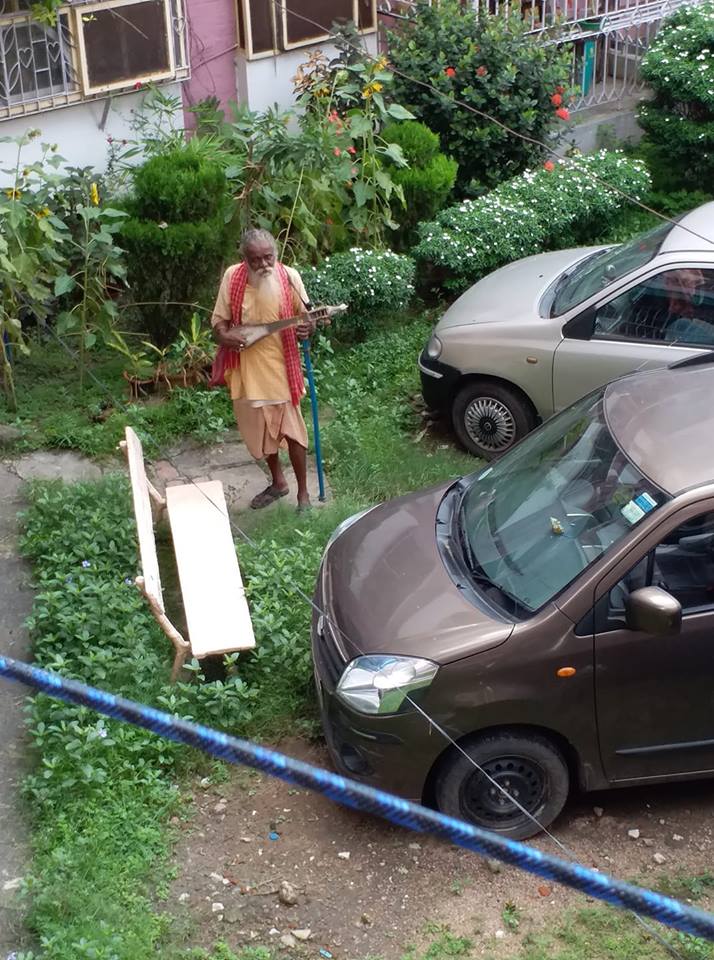He still comes twice a month - ektara in hand, dishevelled hair tied back in a jumbled knot, beard flowing down to his chest, clad in a 'gerua' punjabi and dhoti, with a red gamcha around his neck, jhola on his shoulder, and worn out sandals on his feet. And he still sings the same songs - the trademark baul (wandering minstrels of Bengal) songs of mystic love for an elusive 'moner manush', of life and death,the eternal yearnings of the heart.
But he is a shadow of himself now: his voice has cracked, no more able to sustain the high notes, and after having sung barely two songs he takes his leave. Physically, too, he has shrunk, with an incredible sadness sculpted on his face.
In his heydays, 25/30 years back, he was a robust man - in body and voice. And usually sang upwards of an hour in full-throated ease. His eyes would mostly be closed, his soul immersed in the beauty of the music and the profundity of the thoughts contained in the lyrics. And there would be a faint smile hovering on his lips, when opening his eyes he found an appreciative audience - more than a dozen pairs of innocent eyes - staring down at him from their balconies. I was one of them.
I grew up in a housing complex where three blocks of flats and their balconies faced each other in a semi-circle with a sizable playground in their midst. It is here that he sang; and between songs, would move around the circumference of that circle, and sometimes stand right in the middle of the playground - making it a stage performance without a stage.
The bunch of us kids growing up together in the complex ranged all the way from primary school to college and university. It was however the primary school children who constituted the most loyal audience of the baul; and among them, no one heard him with more attention than me. I was actually egged on by my mother, who, in between her household chores, would give me money to give to the baul; and sometimes pausing in her work would listen to a song or two herself. 'What a voice', she would frequently marvel, and had a great desire to tape it in a cassette player. She had gone through this major recording phase - recording the voices and memories of our grandmothers when they visited us, our (my sister and mine) stupid conversations at home, her favourite poems in her own voice. All on a PERK tape-recorder. But the baul's voice was unfortunately never recorded, and very few survive of the other recordings as well.
It is ironic that the more technologically advanced audio-systems became, the less enthusiastic we got about recording in the family. The PERK was followed in our home by a VIDEOCON 'two-in-one' cassette player and recorder, which was succeeded after more than a decade by a PHILIPS radio, cassette-cum-disc player. And then with the coming of computers, we started listening on desktops, later laptops, and finally mobiles. My mother's enthusiasm for recording had waned long ago. And we never had much time to indulge in such luxuries after school. In our college and university years, we were never there when the baul came to sing. And later, most of us children left the building - for studies, work, marriage - to other places within India and abroad. With us gone, the baul lost his principal audience. No wonder-eyed girl stood on her balcony to listen to him. The stage itself changed irrevocably - the playground being transformed into an open garage to accommodate the increasing cars in the building. Only some change was thrown down to him wrapped in paper and plastic from the upper floors, and through balcony-railings by those on the ground floor.
'Tara ma, keu nei'? (Is there no one?) he cries out these days after singing - more piercingly, desperately, than ever before. Trying to tease out a reluctant audience. Some change still comes his way in response to that - usually from four fixed families who have retained some sympathy for him despite the failing voice. But the honest answer to his question is: 'No, there is none'.


